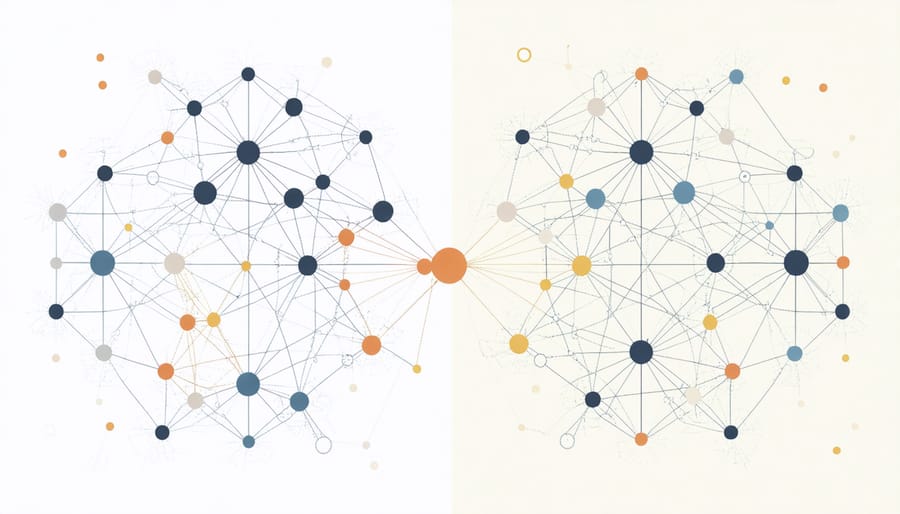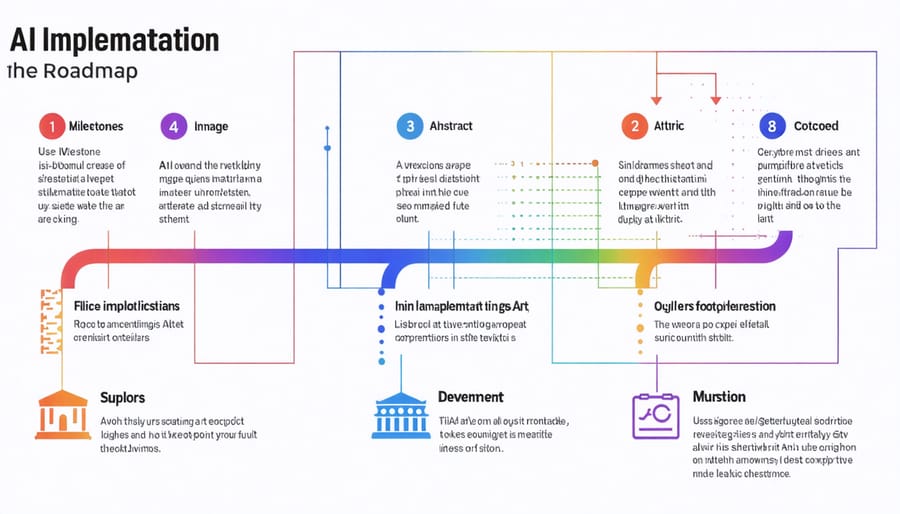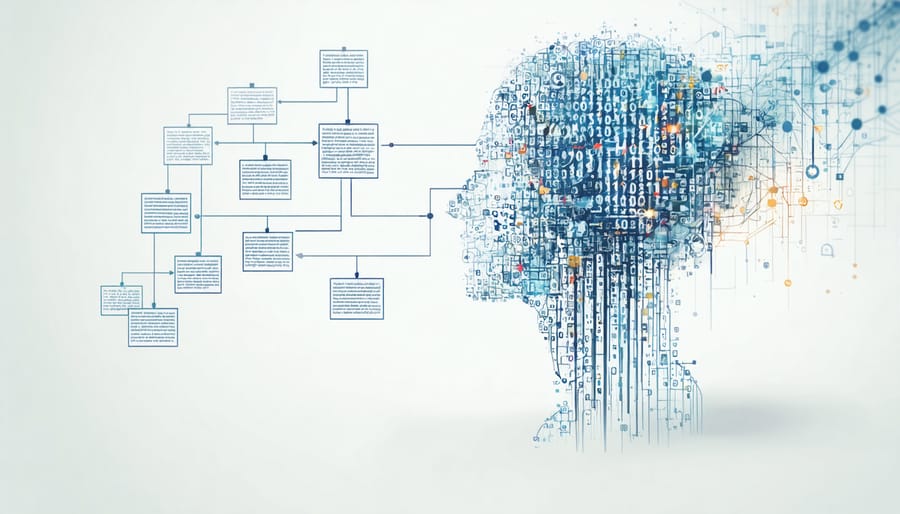Transform your organization by redesigning workflows around artificial intelligence and data-driven decision making. Today’s most successful companies aren’t just adopting new technologies—they’re fundamentally reimagining how work gets done.
Organizations that thrive in the digital age share three critical innovation patterns: They build flexible team structures that can rapidly adapt to market changes, they embrace data-driven experimentation over rigid planning, and they create cultures where continuous learning is deeply embedded in daily operations.
The pace of change demands more than incremental improvements. Forward-thinking leaders are implementing radical new approaches like AI-powered predictive analytics for strategic planning, blockchain for supply chain transparency, and machine learning algorithms that augment human decision-making. These aren’t just efficiency tools—they’re catalysts for entirely new business models and competitive advantages.
Yet the most powerful organizational innovations often come from rethinking fundamental assumptions about how work should be structured. Virtual teams, decentralized authority, and hybrid workforce models are enabling levels of agility and innovation that were impossible just a few years ago. Success now depends on building organizations that can evolve as quickly as the technology that powers them.
The New Face of AI-Driven Organizational Innovation
From Hierarchies to Neural Networks
Traditional organizational hierarchies, with their rigid pyramidal structures, are rapidly evolving in the age of artificial intelligence. AI-powered systems are enabling companies to shift from static organizational charts to dynamic, neural-network-inspired structures that can adapt and respond to changes in real-time.
These new organizational models mirror how AI systems process information, with multiple interconnected nodes working simultaneously rather than following a strict top-down approach. For example, companies like Spotify and Google have adopted “squad” or “pod” structures, where small, cross-functional teams can reorganize quickly based on project needs and market demands.
AI algorithms now help organizations identify optimal team compositions, predict project outcomes, and suggest the most effective collaboration patterns. This data-driven approach allows companies to break free from traditional reporting lines and create more fluid, project-based structures where expertise and resources flow naturally to where they’re needed most.
The result is a more resilient organization that can quickly adapt to market changes, foster innovation, and maintain competitiveness in an increasingly dynamic business environment. As AI technology continues to evolve, we can expect even more sophisticated organizational models that blur the lines between human and machine intelligence.

Real-Time Decision Making
Modern organizations are increasingly embracing data-driven decision making to stay competitive in today’s fast-paced business environment. Through advanced analytics and artificial intelligence, companies can now process vast amounts of information in real-time, enabling quick and informed choices that would have taken days or weeks in the past.
This transformation is particularly evident in industries like e-commerce and manufacturing, where AI-powered systems continuously monitor inventory levels, customer behavior, and market trends. For example, major retailers use smart algorithms to automatically adjust pricing and stock levels based on real-time demand, reducing waste and maximizing profits.
The impact of real-time decision making extends beyond operational efficiency. Organizations are seeing improved customer satisfaction through instantaneous responses to market changes and personalized service delivery. Teams can now collaborate more effectively, with access to shared dashboards and automated alerts that highlight potential issues before they become problems.
However, successful implementation requires a balanced approach. While automation speeds up processes, human oversight remains crucial for strategic decisions and maintaining ethical considerations in business operations.
Leading Innovation in the AI Age
Building AI-Ready Teams
Building AI-ready teams requires a strategic blend of technical expertise, domain knowledge, and adaptable mindsets. Organizations must focus on creating diverse, cross-functional groups that can effectively leverage both human intelligence and AI capabilities.
Start by identifying key roles needed in your AI team. Data scientists and machine learning engineers form the technical core, but equally important are business analysts who understand operational needs, and domain experts who bring industry-specific knowledge. Include project managers who can coordinate between technical and non-technical team members, ensuring smooth collaboration and communication.
Training existing staff is crucial for successful AI integration. Implement upskilling programs that cover basic AI concepts, data literacy, and tools relevant to your organization’s needs. This helps bridge the gap between technical and non-technical team members while fostering a culture of continuous learning.
Consider implementing a “pod” structure, where small, autonomous teams work on specific AI initiatives. Each pod should include technical experts, business stakeholders, and end-users to ensure comprehensive perspective and practical application of AI solutions.
Encourage cross-pollination of ideas by rotating team members between different projects and departments. This practice helps spread AI knowledge throughout the organization while building versatile skill sets.
Remember that successful AI teams aren’t just about technical skills – emotional intelligence, creativity, and problem-solving abilities are equally important. Look for team members who demonstrate adaptability and enthusiasm for learning new technologies while maintaining strong interpersonal skills.

Fostering an AI Innovation Culture
Creating a culture that embraces AI-driven transformation requires a deliberate and systematic approach. Organizations must first acknowledge that successful AI implementation isn’t just about technology—it’s about people and their mindset.
Start by encouraging experimentation and creating safe spaces for teams to test AI solutions. This might involve setting up innovation labs or dedicating specific time for AI-related projects. Companies like Google and Microsoft have successfully implemented “20% time” policies, allowing employees to explore AI initiatives alongside their regular duties.
Leadership plays a crucial role in fostering this culture. Leaders should demonstrate commitment by actively participating in AI initiatives, providing necessary resources, and celebrating both successes and learning opportunities from failures. Regular town halls and workshops can help demystify AI and build confidence across all organizational levels.
Education is another vital component. Implement training programs that help employees understand AI basics and its potential applications in their daily work. Consider creating AI champions within different departments who can bridge the gap between technical teams and business units.
Remember to establish clear metrics for measuring AI innovation success, but avoid focusing solely on immediate ROI. Some benefits, like improved employee engagement and creative problem-solving, may take time to materialize but are equally valuable for long-term success.
Managing the Human-AI Interface
Successfully integrating AI into the workplace requires a thoughtful approach to human-AI collaboration. Organizations must establish clear protocols for how employees interact with AI automation systems, ensuring both parties complement each other’s strengths.
The key lies in defining distinct roles and responsibilities. Humans excel at creative thinking, emotional intelligence, and complex decision-making, while AI systems handle data processing, pattern recognition, and repetitive tasks. Creating detailed workflow maps that outline when and how humans should intervene in AI processes helps maintain efficiency while preventing confusion or overlap.
Training programs play a crucial role in this integration. Employees need to understand not just how to operate AI tools, but also how to interpret their outputs and when to question results. Regular feedback sessions between teams and AI developers ensure systems evolve to meet real workplace needs.
Communication channels should be established for employees to report AI-related issues or suggest improvements. This two-way dialogue helps refine the technology while giving workers a sense of agency in the transformation process.
Organizations should also implement clear escalation procedures for when AI systems encounter unusual situations or potential errors. This ensures human oversight remains effective while maintaining operational efficiency.
Practical Implementation Framework

Assessment and Planning
Before implementing organizational innovations, it’s crucial to assess your company’s readiness and create a structured implementation plan. Start by evaluating your current organizational capabilities across key dimensions: technology infrastructure, employee skills, leadership support, and cultural adaptability.
Conduct a thorough gap analysis by comparing your present state with desired future outcomes. This assessment should include surveys, interviews with stakeholders, and data analysis of existing processes. Pay special attention to potential resistance points and resource constraints that might impact the innovation journey.
Create a readiness scorecard that measures:
– Technical infrastructure capabilities
– Employee digital literacy levels
– Change management effectiveness
– Resource availability
– Cultural alignment with innovation goals
Once you’ve completed the assessment, develop a comprehensive implementation roadmap. This should outline specific milestones, timelines, and responsibilities. Break down the innovation journey into manageable phases, typically including:
1. Initial pilot programs
2. Focused testing and refinement
3. Staged rollout across departments
4. Full-scale implementation
5. Continuous improvement cycles
Remember to build in feedback loops and adjustment periods throughout the implementation process. Regular check-ins and progress measurements help ensure the innovation initiative stays on track while allowing for necessary adaptations based on real-world results and employee feedback.
Finally, establish clear success metrics and monitoring systems to track progress and demonstrate ROI to stakeholders.
Execution and Adaptation
Successful implementation of organizational innovations requires a methodical approach combined with flexibility. Start by creating a clear rollout plan that includes specific milestones, success metrics, and designated team responsibilities. Consider implementing changes in phases, beginning with a pilot program in a smaller department or team to test effectiveness and identify potential challenges.
Communication is crucial during the execution phase. Establish regular feedback channels where employees can share their experiences and concerns. This might include anonymous surveys, team meetings, or digital suggestion boxes. Remember that resistance to change is natural, so provide adequate training and support resources to help staff adapt to new systems and processes.
Monitor key performance indicators (KPIs) closely during the implementation phase. These might include productivity metrics, employee satisfaction scores, or process efficiency measurements. Use this data to make informed adjustments to your innovation strategy.
Be prepared to pivot or modify your approach based on real-world results. If certain aspects aren’t working as intended, don’t hesitate to make necessary changes. Create an agile framework that allows for quick adaptations while maintaining the core objectives of your innovation initiative.
Document both successes and failures throughout the process. This information becomes valuable for future innovation projects and helps create a culture of continuous improvement within the organization. Regular progress updates to stakeholders help maintain support and momentum for the changes being implemented.
Measuring Success and Scaling Innovation
Evaluating the success of organizational innovations requires a structured approach that combines both quantitative and qualitative metrics. Organizations should start by establishing clear baseline measurements before implementing changes, focusing on key performance indicators (KPIs) such as productivity rates, employee satisfaction scores, and operational efficiency metrics. Measuring AI implementation success becomes more effective when organizations track both immediate impacts and long-term transformational outcomes.
A practical framework for measuring innovation success includes three key dimensions: operational efficiency, employee engagement, and business value creation. Organizations can track metrics such as reduced process completion times, decreased error rates, and improved customer satisfaction scores. Regular pulse surveys and feedback sessions with employees help gauge adoption rates and identify areas for improvement.
When it comes to scaling successful innovations, organizations should follow a phased approach:
1. Pilot Testing: Start with small-scale implementations in controlled environments
2. Impact Assessment: Gather data and feedback from initial deployments
3. Refinement: Adjust and optimize based on learnings
4. Controlled Expansion: Gradually roll out to larger groups or departments
5. Full-Scale Implementation: Deploy across the entire organization
Success stories often emerge when organizations maintain flexibility in their scaling approach. For example, a global manufacturing company successfully scaled their AI-driven quality control system by first implementing it in a single production line, then expanding to multiple facilities only after demonstrating clear ROI and addressing implementation challenges.
To ensure sustainable scaling, organizations should:
– Document best practices and lessons learned
– Create standardized implementation playbooks
– Develop internal champions and support networks
– Maintain open communication channels
– Continuously monitor and adjust based on feedback
Remember that scaling innovation isn’t just about technology deployment—it’s about creating a culture that embraces change and continuous improvement.
As we look to the future of organizational innovation, artificial intelligence continues to reshape how businesses operate and adapt. The successful implementation of AI-driven changes requires a delicate balance between technological advancement and human-centered approaches. Organizations that have embraced this dual focus have demonstrated remarkable improvements in efficiency, employee satisfaction, and market competitiveness.
Key takeaways from our exploration reveal that successful AI-driven organizational innovations share common elements: clear strategic alignment, robust change management processes, and continuous learning frameworks. The most effective implementations start small, gather feedback, and scale gradually, allowing organizations to adapt and refine their approaches based on real-world results.
Looking ahead, we can expect to see more sophisticated AI applications that enhance decision-making, automate routine tasks, and create more collaborative work environments. The emergence of responsible AI practices will become increasingly important, as organizations strive to balance innovation with ethical considerations and employee well-being.
For organizations beginning their AI transformation journey, the path forward is clear: start with a solid foundation of digital literacy, invest in employee training, and maintain a flexible approach to implementation. Success will come to those who view AI not as a replacement for human capability, but as a powerful tool to augment and enhance human potential.
The future of organizational innovation lies in creating symbiotic relationships between AI systems and human expertise, leading to more resilient, adaptive, and successful organizations.

